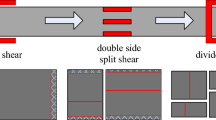Abstract
The cutting stock problem of construction steel bars has a strongly heterogeneous assortment of demand items. This research develops new solution procedures which result in the efficient cutting plans with minimum trim loss and number of stocks used. The procedures consist of three steps namely the generation of a set of efficient cutting patterns, the optimization of one dimensional cutting stock problem, and the cut of undersupplied items with the best fit decreasing algorithm. The first step, the Intensive Search algorithm generates a set of efficient cutting patterns which are made up of various demand lengths according to their demands quantities. The second step, the optimization of One Dimensional Cutting Stock Problem (1D-CSP) using Genetic Algorithm is proceeded to determine the numbers of cutting times of the patterns. All these cut items are constrained to not exceed the demanded pieces. The third step, few remaining undersupplied items are cut using the best fit decreasing algorithm. Test results showed that the solutions from different runtimes gave comparable percentages of waste. Important parameters such as the number of efficient cutting patterns and the allowable trim loss of the patterns could affect the solutions. Test results indicated that the new solution procedures could give low-waste cutting plans.
Similar content being viewed by others
References
Cherri, A. C., Arenales, M. N., and Yanasse, H. H. (2009). “The onedimensional cutting stock problem with usable leftover — A heuristic approach.” European Journal of Operational Research, Vol. 196, No. 3, pp. 897–908.
Coffman Jr, E. G., Garey, M. R., and Johnson, D. S. (1984). “Approximation algorithms for bin-packing: An updated survey.” Algorithm Design for Computer System Design, Wein, pp. 49–106.
Dyckhoff, H. (1990). “A typology of cutting and packing problems.” European Journal of Operational Research, Vol. 44, No. 2, pp. 145–159.
Gilmore, P. C. and Gomory, R. E. (1961). “A linear programming approach to the cutting-stock problem.” Operations Research, Vol. 9, No. 6, pp. 849–859.
Gilmore, P. C. and Gomory, R. E. (1963). “A linear programming approach to the cutting stock problem — part II.” Operations Research, Vol. 11, No. 6, pp. 863–888.
Gradisar, M., Jesenko, J., and Resinovic, G. (1997). “Optimization of roll cutting in clothing industry.” Computers & Operations Research, Vol. 24, No. 10, pp. 945–953.
Gradisar, M., Resinovic, G., and Kljajic, M. (1999). “A hybrid approach for optimization of one-dimensional cutting.” European Journal of Operational Research, Vol. 119, No. 3, pp. 719–728.
Gramani, M. C. N. and França, P. M. (2006). “The combined cutting stock and lot-sizing problem in industrial processes.” European Journal of Operational Research, Vol. 174, No. 1, pp. 509–521.
Haessler, R. W. and Sweeney, P. E. (1991). “Cutting stock problems and solution procedures.” European Journal of Operational Research, Vol. 54, No. 2, pp. 141–150.
Hinterding, R. and Khan, L. (1994). Genetic algorithms for cutting stock problems: With and without contiguity, Victoria University of Technology Australia.
Liang, K. H., Yao, X., Newton, C., and Hoffman, D. (2002). “A new evolutionary approach to cutting stock problems with and without contiguity.” Computers & Operations Research, Vol. 29, No. 12, pp. 1641–1659.
Pierce, J. F. (1964). Some large-scale production scheduling problems in the paper industry, Prentice-Hall.
Reinertsen, H. and Vossen, T. W. M. (2010). “The one-dimensional cutting stock problem with due dates.” European Journal of Operational Research, Vol. 201, No. 3, pp. 701–711.
Salem, O., Shahin, A., and Khalifa, Y. (2007). “Minimizing cutting wastes of reinforcement steel bars using genetic algorithms and integer programming models.” Journal of Construction Engineering and Management, Vol. 133, No. 12, pp. 982–992.
Vahrenkamp, R. (1996). “Random search in the one-dimensional cutting stock problem.” European Journal of Operational Research, Vol. 95, No. 1, pp. 191–200.
Wäscher, G., Haußner, H., and Schumann, H. (2007). “An improved typology of cutting and packing problems.” European Journal of Operational Research, Vol. 183, No. 3, pp. 1109–1130.
Yanasse, H. H., and Pinto Lamosa, M. J. (2007). “An integrated cutting stock and sequencing problem.” European Journal of Operational Research, Vol. 183, No. 3, pp. 1353–1370.
Yue, M. (1991). “A simple proof of the inequality FFD (L) 11/9 OPT (L) + 1, L for the FFD bin-packing algorithm.” Acta Mathematicae Applicatae Sinica, Vol. 7, No. 4, pp. 321–331.
Author information
Authors and Affiliations
Corresponding author
Rights and permissions
About this article
Cite this article
Benjaoran, V., Bhokha, S. Three-step solutions for cutting stock problem of construction steel bars. KSCE J Civ Eng 18, 1239–1247 (2014). https://doi.org/10.1007/s12205-014-0238-3
Received:
Revised:
Accepted:
Published:
Issue Date:
DOI: https://doi.org/10.1007/s12205-014-0238-3




